I have followed this tutorial (4. Full-Screen Dialog) which is close to Material design guidelines.
But the interesting thing is, if I use the official code like this:
FragmentManager fragmentManager = getSupportFragmentManager();
FullscreenDialogFragment newFragment = new FullscreenDialogFragment();
FragmentTransaction transaction = fragmentManager.beginTransaction();
transaction.setTransition(FragmentTransaction.TRANSIT_FRAGMENT_OPEN);
transaction.add(android.R.id.content,
newFragment).addToBackStack(null).commit();
I get:
But using the "simple" method of
DialogFragment dialog = new FullscreenDialogFragment();
dialog.show(getSupportFragmentManager(), TAG);
It works as intended:
So what's happening here?
My Code
My dialog class is basically the same except that I did not use this from the tutorial
@NonNull
@Override
public Dialog onCreateDialog(Bundle savedInstanceState) {
Dialog dialog = super.onCreateDialog(savedInstanceState);
dialog.requestWindowFeature(Window.FEATURE_NO_TITLE);
return dialog;
}
But instead I have a specified style file:
<!-- SA suggestion dialog theme. -->
<style name="FullscreenDialogTheme" parent="Base.Theme.AppCompat.DialogWhenLarge">
<item name="android:windowNoTitle">true</item>
<item name="android:windowBackground">@color/colorLightBackground</item>
<item name="android:windowIsFloating">false</item>
<item name="android:windowEnterAnimation">@android:anim/slide_in_left</item>
<item name="android:windowExitAnimation">@android:anim/slide_out_right</item>
</style>
Which I set with
@Override
public void onCreate(@Nullable Bundle savedInstanceState) {
super.onCreate(savedInstanceState);
setStyle(STYLE_NORMAL, R.style.FullscreenDialogTheme);
}
This is the dialog layout xml (I replaced the support widgets with AndroidX)
<?xml version="1.0" encoding="utf-8"?>
<LinearLayout xmlns:android="http://schemas.android.com/apk/res/android"
android:layout_width="match_parent"
android:layout_height="match_parent"
android:background="@android:color/white"
android:fitsSystemWindows="true"
android:orientation="vertical">
<com.google.android.material.appbar.AppBarLayout
android:layout_width="match_parent"
android:layout_height="?attr/actionBarSize">
<LinearLayout
android:layout_width="match_parent"
android:layout_height="match_parent"
android:orientation="horizontal">
<ImageButton
android:id="@+id/sa_dialog_close_btn"
android:layout_width="?attr/actionBarSize"
android:layout_height="?attr/actionBarSize"
android:background="?attr/selectableItemBackgroundBorderless"
android:tint="@android:color/white"
android:src="@drawable/ic_close_white_24dp"
android:contentDescription="@string/sa_dialog_close_btn_content_desc" />
<TextView
android:layout_width="0dp"
android:layout_height="match_parent"
android:layout_weight="1"
android:gravity="center_vertical"
android:text="@string/dialog_title"
android:textAppearance="@style/Base.TextAppearance.AppCompat.Title"
android:textColor="@android:color/white" />
<Button
android:id="@+id/sa_dialog_confirm_btn"
style="@style/Widget.AppCompat.Button.Borderless"
android:layout_width="wrap_content"
android:layout_height="match_parent"
android:gravity="center"
android:paddingLeft="2dp"
android:paddingRight="2dp"
android:text="@string/sa_dialog_confirm"
android:textColor="@android:color/white" />
</LinearLayout>
</com.google.android.material.appbar.AppBarLayout>
<androidx.core.widget.NestedScrollView
android:id="@+id/nested_scroll_view"
android:layout_width="match_parent"
android:layout_height="match_parent"
android:scrollbars="none"
android:scrollingCache="true">
<TextView
android:layout_width="wrap_content"
android:layout_height="wrap_content"
android:layout_gravity="center_horizontal|center_vertical"
android:text="Full Screen Dialog"/>
</androidx.core.widget.NestedScrollView>
And dialog class
public class FullscreenDialogFragment extends DialogFragment {
@BindView(R.id.sa_dialog_close_btn)
ImageButton close_btn;
@BindView(R.id.sa_dialog_confirm_btn)
Button confirm_btn;
//Necessary in fragments
private Unbinder unbinder;
Context mContext;
@Override
public void onCreate(@Nullable Bundle savedInstanceState) {
super.onCreate(savedInstanceState);
setStyle(STYLE_NORMAL, R.style.FullscreenDialogTheme);
}
@Nullable
@Override
public View onCreateView(@NonNull LayoutInflater inflater, @Nullable ViewGroup container, @Nullable Bundle savedInstanceState) {
View view = inflater.inflate(R.layout.dialog_test, container, false);
// mContext = Objects.requireNonNull(container).getContext();
unbinder = ButterKnife.bind(this, view);
close_btn.setOnClickListener(listener -> cancelDialog());
confirm_btn.setOnClickListener(listener -> confirmDialog());
return view;
}
private void cancelDialog() {
dismiss();
}
private void confirmDialog() {
// Toast.makeText(mContext, "Confirmed", Toast.LENGTH_SHORT).show();
}
@Override
public void onDestroy() {
super.onDestroy();
unbinder.unbind();
}
}
I guess it has something to do with this line, as suggested in this answer:
https://stackoverflow.com/a/44085523/1972372
transaction.add(android.R.id.content, fragment)
Where I should reference the layout from the activity that is creating the fragment?
I tried that with the root layout of the activity but only got weird content overlappings:
transaction.add(R.id.sa_activity_parent_layout, newFragment).addToBackStack(null).commit();


